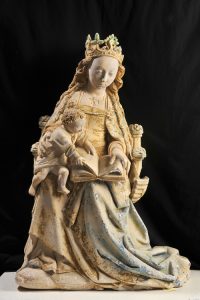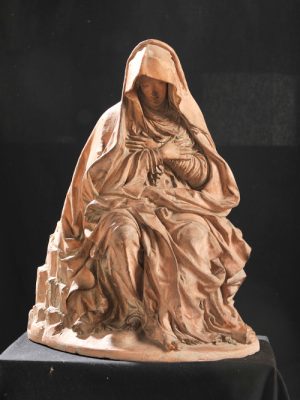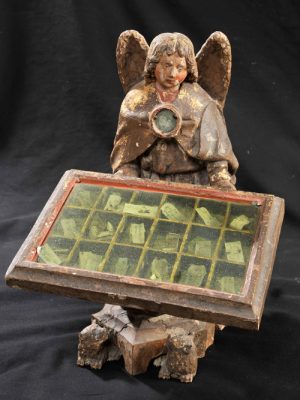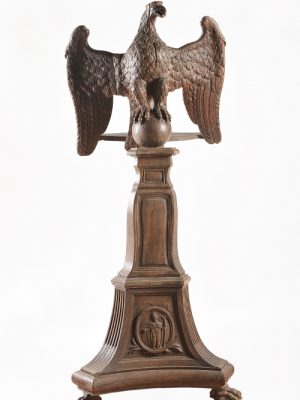Madonna and Child
Anonymous
France
16th century
Stone
Deposit from the commune of Fresnoy-le-Luat, 1975
Classified as a Historical Monument
Inv. D1975.1.1
______________
This group of polychrome stone statues of the Madonna and Child has been classified as a Historical monument since 1925. Originally, it was to be found in the Luat chapel, in the commune of Fresnoy-le-Luat.
The Virgin is elegantly clothed in a low-cut ochre dress tied at the front. Her long blue mantle with decorated edges is held together by a cord with two flower-shaped clasps. She is wearing a crown and is sitting on an X-shaped seat called Dagobert whose extremities are decorated with floral motifs. The Child Jesus, seated on her right leg, is looking at an open book she is holding. With his left forefinger, the Child is showing his mother a precise passage in the text. This representation differs from usual iconographies that mostly depict a mother teaching her child, as in the case of Saint Ann with her daughter Mary. Here the iconography is reversed: Jesus is teaching his Mother, pointing out to her the important passages to read and meditate on.
The top of Mary’s head and the back of the artwork are not sculpted, and the latter has even been hollowed out in the back to lighten the ensemble as much as possible, thus indicating that the sculpture was meant to be seen only from the front, its back to the wall, in an alcove or against a panel.
The coat of arms visible on the armrest has not yet been identified. It is nevertheless probable that the patron of this artwork was a powerful local lord.
In the surroundings of the Valois, Madonnas and Child with an open book are few during the 15th and 16th centuries, whereas the theme is omnipresent in Brussels during the 15th century. Although probably from a workshop in the Île-de-France, this statue still shows influences straight from Flanders.
Two statues showing Saint John and Saint James, also deposited in the museum under the inventory number D1975.1.4 and D1975.1.3, flanked this Madonna and Child in the Luat chapel. In view of the numerous stylistic resemblances, they are probably from the same workshop, and formed a large ensemble of statues meant to give more prestige to the little chapel that housed them.















